The Safety Laser Scanner Market is estimated to be valued at USD 357.1 million in 2025 and is projected to reach USD 651.6 million by 2035, registering a compound annual growth rate (CAGR) of 6.2% over the forecast period.
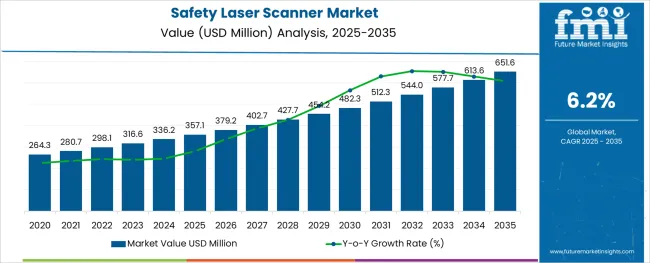
The safety laser scanner market is gaining strong momentum as industrial automation, smart factory deployment, and worker safety protocols become increasingly sophisticated. Demand is being propelled by stringent international safety regulations and a heightened focus on reducing workplace injuries in environments with heavy machinery and mobile equipment. The integration of safety laser scanners with robotics, conveyor systems, and automated guided vehicles is enabling precise area monitoring and personnel protection in real time.
Advancements in compact designs, multi-zone monitoring, and Ethernet-based connectivity are enhancing installation flexibility and interoperability with existing safety PLCs. Industries are prioritizing non-contact safety solutions that offer configurable detection fields and reduce downtime from false triggers.
As manufacturers adopt predictive maintenance and Industry 4.0 frameworks, laser scanners with embedded diagnostics and self-monitoring capabilities are expected to dominate future demand. Ongoing growth will be reinforced by innovations in software-defined scanning algorithms and wider applicability across sectors such as logistics, food processing, and intralogistics.
The market is segmented by Type and End User and region. By Type, the market is divided into Stationary Safety Laser Scanner and Mobile Safety Laser Scanner. In terms of End User, the market is classified into Automotive, Food & Beverages, Healthcare & Pharmaceuticals, Consumer Electronics, and Others. Regionally, the market is classified into North America, Latin America, Western Europe, Eastern Europe, Balkan & Baltic Countries, Russia & Belarus, Central Asia, East Asia, South Asia & Pacific, and the Middle East & Africa.
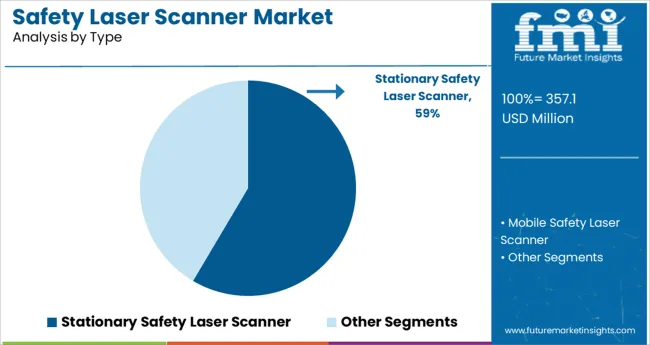
The stationary safety laser scanner segment is projected to hold 58.50% of the total market revenue in 2025, making it the leading type category. This dominance is attributed to its widespread use in fixed machinery guarding, hazardous zone protection, and access control within industrial production lines.
The fixed nature of these scanners allows for high-precision area detection, making them well suited for monitoring static zones where human-machine interaction is frequent. Their ability to define multiple safety and warning zones, combined with seamless integration into programmable logic controllers, has made them essential for high-volume manufacturing operations.
Additionally, the stationary models support greater field range and faster response times, which are critical in environments with stringent safety compliance standards. Cost-efficiency in large-scale installations and reduced maintenance needs further strengthen the segment’s leadership in applications requiring permanent safeguarding.
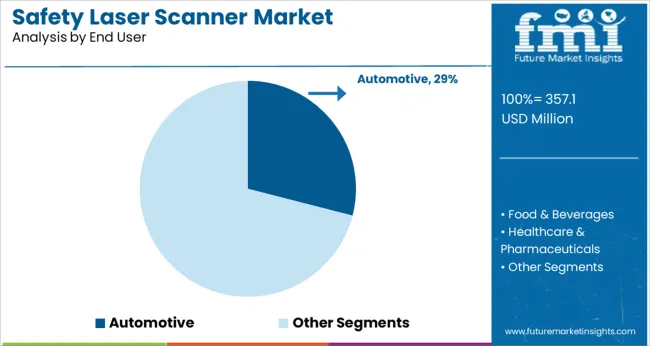
The automotive end user segment is expected to contribute 29.00% of the overall market revenue in 2025, positioning it as the leading industrial application. This leadership stems from the sector’s high level of automation, where robotic arms, conveyor belts, and assembly lines operate in close proximity to human workers.
The need for real-time perimeter protection and dynamic obstacle detection has accelerated the adoption of safety laser scanners across body shops, paint booths, and final assembly areas. Automotive OEMs and Tier 1 suppliers are deploying these scanners to ensure compliance with ISO 13849 and IEC 61496 standards, while simultaneously enhancing productivity through uninterrupted machine operation.
The integration of scanners with AGVs and collaborative robots is also becoming standard practice in smart automotive plants. With growing investment in EV manufacturing and modular production layouts, the demand for flexible, software-configurable safety systems is expected to keep the automotive sector at the forefront of safety laser scanner adoption.
| Market Statistics | Details |
|---|---|
| H1,2024 (A) | 7.8% |
| H1,2025 Projected (P) | 7.2% |
| H1,2025 Outlook (O) | 6.9% |
| BPS Change : H1,2025 (O) - H1,2025 (P) | (-) 30 ↓ |
| BPS Change : H1,2025 (O) - H1,2024 (A) | (-) 90 ↓ |
Future Market Insights anticipates a comparison and review analysis for safety laser scanner market subjected to assembly of industry factors. Safety laser scanners are sensing devices which are designed for the protection of personnel from injury and can be mounted for the detection of undesirable entrances into hazardous areas.
The difference in the BPS values observed in the safety laser scanner market in H1, 2025 - Outlook over H1, 2025 projected implies a 30-unit reduction, according to the FMI analysis. Factors which impact and hinder the growth of the market are high initial cost and lack of funds due to involvement of complex technologies and high end features.
Thus, the cost associated with installation, maintenance and service proves to be a major barrier in the growth of safety laser scanners.
Furthermore, compared to H1, 2024, the market is projected to decline by 90 BPS in H1 -2025 (O). High market competition for products with similar offerings across the market such as safety mats hampers the market growth. Moreover, leaking oil, dust or grease can trip the safety laser scanners which restricts its operations and slows the market demand.
A safety laser scanner is a development in machinery safety, which has had a transforming impact on machinery development and productivity. Safety laser scanners have introduced new methods such as 3D scanning systems to provide detailed analysis for road surveying and traffic construction.
The safety laser scanner market is estimated to rise at 6.2% CAGR between 2025 and 2035 in comparison with 5.0% CAGR registered during 2013 to 2024.
A safety laser scanner detects when a person approaches within the range of any hazardous movement. In case the warning field is accessed, a controlled barking system that warns against the hazardous movement is activated, following which access to the protected field is prevented. In situations where it is difficult to watch in the danger zones, a safety laser scanner is installed to detect the entry of a person, and it helps prevent the same.
Safety laser scanners have applications for stationary as well as mobile purposes. They are often used to help avoid the collision of vehicles as well as for vehicle navigation applications.
As safety laser scanners are flexible, they are widely used for mobile applications. For mobile applications, these scanners have a special feature known as zone set switching. These scanners provide this feature through various factors, such as safety standards, resolution, physics, traffic, environment and maximum range.
As per the requirement of a specific operation or a process, the safety laser scanner can be programmed into different zone sets, which can be switched from one set to another based on specific needs. This ability of safety laser scanners to dynamically change is expected to be one of the major factors driving the market, during the forecast period.
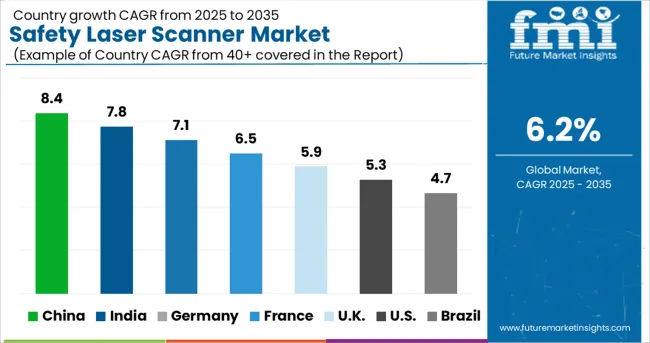
How big is the Opportunity for Adoption of Safety Laser Scanners in the China?
Asia Pacific excluding Japan is predicted to remain one of the most attractive markets during the forecast period. According to the study, China is expected to account for nearly 40.7%
The growth of the safety laser scanners market in China depends on the growth of the consumer electronics and manufacturing sectors, where safety laser scanners are extensively used. 2D safety laser scanners are used in consumer electronics and automotive sector. Preference for 3D safety laser scanners is another key trend in safety laser scanners market in the Asia Pacific excluding Japan region.
The safety laser scanners demand in the Germany is expected to rise at a notable CAGR of around 7.9% over the forecast period. Increasing demand for safety laser scanner for logistics and packaging operations in manufacturing facilities is driving the demand for Germany safety laser scanners market.
However, Spain and BENELUX together are estimated to create 13% of the total incremental $ opportunity created by the European region. Owing to technological advancement such as time-of-flight technology, and continues innovation in automotive industry, the demand for safety laser scanner is increasing in this region.
India market is set to report the one of the largest manufacturer of safety laser scanners, and market size is expected reach 1.5X by 2035. The India market is anticipated to create an absolute dollar opportunity of ~USD 357.1 Million during 2025 to 2035.
India safety laser scanners market growth can be attributed to the rapid increase in production facilities in India for end-user industries such as healthcare & pharmaceuticals and automotive. Further, government rules and regulations are also in favor of increasing the number of safety laser scanners manufacturing facilities in this region.
Why is Demand for Mobile Safety Laser Scanner Rising?
The stationary safety laser scanner segment by type will dominate the global demand for safety laser scanner, and expected to grow by 1.3X between 2025 & 2035. However, mobile safety laser scanner segment is set to witness highest growth rate of nearly 7.5% CAGR during 2025 to 2035.
The increasing usage of mobile safety laser scanner is fuelling the global safety laser scanner market. It also offers various feature such as area protection, wide detection range, high-precision measurement data, ultra-compact design, and others.
On the basis of end user, safety laser scanner is sub-segmented into automotive, food & beverages, healthcare & pharmaceuticals, consumer electronics, and others. Automotive sub-segment is expected to dominate the overall end user segment in terms of revenue share as 37.5% in 2025.
The increasing usage of safety laser scanner for automotive applications such as vehicle navigation, robotic work cells, automated guided vehicles (AGV), and others, to drive market growth. Safety laser scanners are widely employed in the pharmaceutical manufacturing business, which is primarily concerned with drug production, which is the process of synthesising pharmaceutical medications on a big scale.
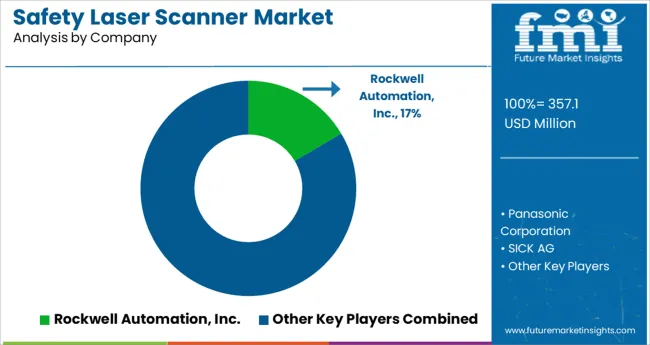
The safety laser scanner manufacturer focuses on launching innovative products and expanding its safety laser scanner offerings to deliver enhanced technology as well as offer new and upgraded products in new markets. The business alliances strategy helps the company in product development, technological management, and in expanding its customer base.
For instance:
| Attribute | Details |
|---|---|
| Market value in 2024 | USD 280.2 Million |
| Market CAGR 2013 to 2024 | 5.0% |
| Share of top 5 players | Around 30% |
| Forecast Period | 2025 to 2035 |
| Historical Data Available for | 2013 to 2024 |
| Market Analysis | million for Value |
| Key regions covered | North America; Latin America; Europe; Middle East and Africa; APEJ |
| Key countries covered | USA, Canada, Brazil, Mexico, Germany, UK, France, Spain, Russia, China, India, Malaysia, Singapore, Australia, Japan, GCC countries, Israel, and South Africa |
| Key market segments covered |
Type, End User, Region |
| Key companies profiled |
Rockwell Automation, Inc.; Panasonic Corporation; SICK AG; Omron Corporation; Keyence Corporation; IDEC Corporation; Pepperl+Fuchs GmbH; Banner Engineering; Leuze electronic GmbH + Co. KG; Hans TURCK GmbH & Co. KG |
| Report coverage | Market forecast, company share analysis, competition intelligence, DROT analysis, market dynamics and challenges, and strategic growth initiatives |
| Customization & pricing | Available upon request |
The global safety laser scanner market is estimated to be valued at USD 357.1 million in 2025.
It is projected to reach USD 651.6 million by 2035.
The market is expected to grow at a 6.2% CAGR between 2025 and 2035.
The key product types are stationary safety laser scanner and mobile safety laser scanner.
automotive segment is expected to dominate with a 29.0% industry share in 2025.






Our Research Products

The "Full Research Suite" delivers actionable market intel, deep dives on markets or technologies, so clients act faster, cut risk, and unlock growth.

The Leaderboard benchmarks and ranks top vendors, classifying them as Established Leaders, Leading Challengers, or Disruptors & Challengers.

Locates where complements amplify value and substitutes erode it, forecasting net impact by horizon

We deliver granular, decision-grade intel: market sizing, 5-year forecasts, pricing, adoption, usage, revenue, and operational KPIs—plus competitor tracking, regulation, and value chains—across 60 countries broadly.

Spot the shifts before they hit your P&L. We track inflection points, adoption curves, pricing moves, and ecosystem plays to show where demand is heading, why it is changing, and what to do next across high-growth markets and disruptive tech

Real-time reads of user behavior. We track shifting priorities, perceptions of today’s and next-gen services, and provider experience, then pace how fast tech moves from trial to adoption, blending buyer, consumer, and channel inputs with social signals (#WhySwitch, #UX).

Partner with our analyst team to build a custom report designed around your business priorities. From analysing market trends to assessing competitors or crafting bespoke datasets, we tailor insights to your needs.
Supplier Intelligence
Discovery & Profiling
Capacity & Footprint
Performance & Risk
Compliance & Governance
Commercial Readiness
Who Supplies Whom
Scorecards & Shortlists
Playbooks & Docs
Category Intelligence
Definition & Scope
Demand & Use Cases
Cost Drivers
Market Structure
Supply Chain Map
Trade & Policy
Operating Norms
Deliverables
Buyer Intelligence
Account Basics
Spend & Scope
Procurement Model
Vendor Requirements
Terms & Policies
Entry Strategy
Pain Points & Triggers
Outputs
Pricing Analysis
Benchmarks
Trends
Should-Cost
Indexation
Landed Cost
Commercial Terms
Deliverables
Brand Analysis
Positioning & Value Prop
Share & Presence
Customer Evidence
Go-to-Market
Digital & Reputation
Compliance & Trust
KPIs & Gaps
Outputs
Full Research Suite comprises of:
Market outlook & trends analysis
Interviews & case studies
Strategic recommendations
Vendor profiles & capabilities analysis
5-year forecasts
8 regions and 60+ country-level data splits
Market segment data splits
12 months of continuous data updates
DELIVERED AS:
PDF EXCEL ONLINE
Safety Label Market Size and Share Forecast Outlook 2025 to 2035
Safety Bottle Tote Carriers Packaging Market Size and Share Forecast Outlook 2025 to 2035
Safety Towing System Market Size and Share Forecast Outlook 2025 to 2035
Safety Syringe Market Size and Share Forecast Outlook 2025 to 2035
Safety Actuators Market Size and Share Forecast Outlook 2025 to 2035
Safety Needles Market Size and Share Forecast Outlook 2025 to 2035
Safety Limit Switches Market Size and Share Forecast Outlook 2025 to 2035
Safety Reporting Systems Market Size and Share Forecast Outlook 2025 to 2035
Safety Eyewear Market Analysis - Size, Share, and Forecast 2025 to 2035
Safety Box for Syringe Market Size, Share & Forecast 2025 to 2035
Safety Valve Market Size, Growth, and Forecast 2025 to 2035
Safety Relays Market Size, Share, and Forecast 2025 to 2035
Safety Instrumentation Systems Market – Trends & Forecast 2025 to 2035
Safety Mirrors Market - Growth & Forecast 2025 to 2035
Safety Switches Market Trends – Growth & Forecast 2025 to 2035
Safety Interlock Switches Market Analysis by Actuation Method, Application and End-use Industry and Region 2025 to 2035
Safety Light Curtains Market Growth - Trends & Forecast 2025 to 2035
Key Companies & Market Share in the Safety Eyewear Sector
Industry Share Analysis for Safety Box for Syringe Companies
Safety and Process Filter Market Growth – Trends & Forecast 2024-2034

Thank you!
You will receive an email from our Business Development Manager. Please be sure to check your SPAM/JUNK folder too.
Chat With
MaRIA